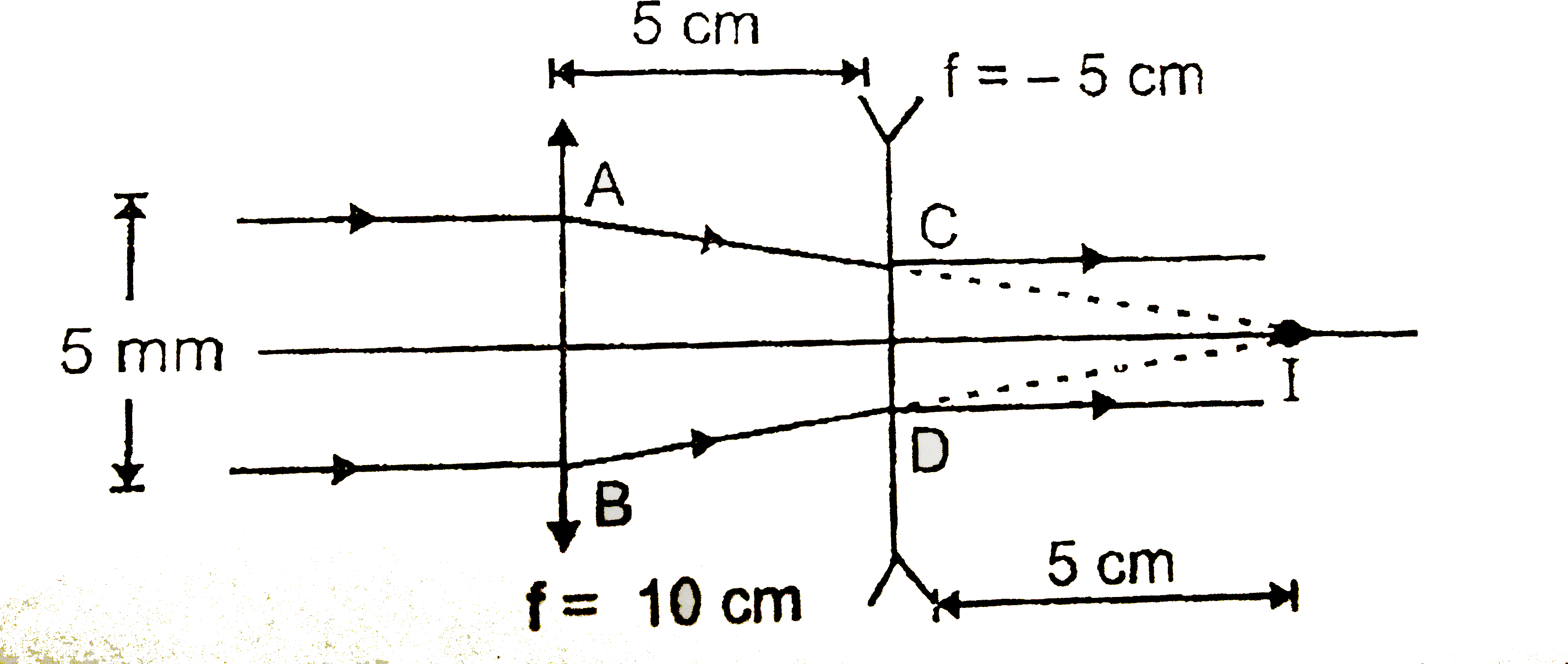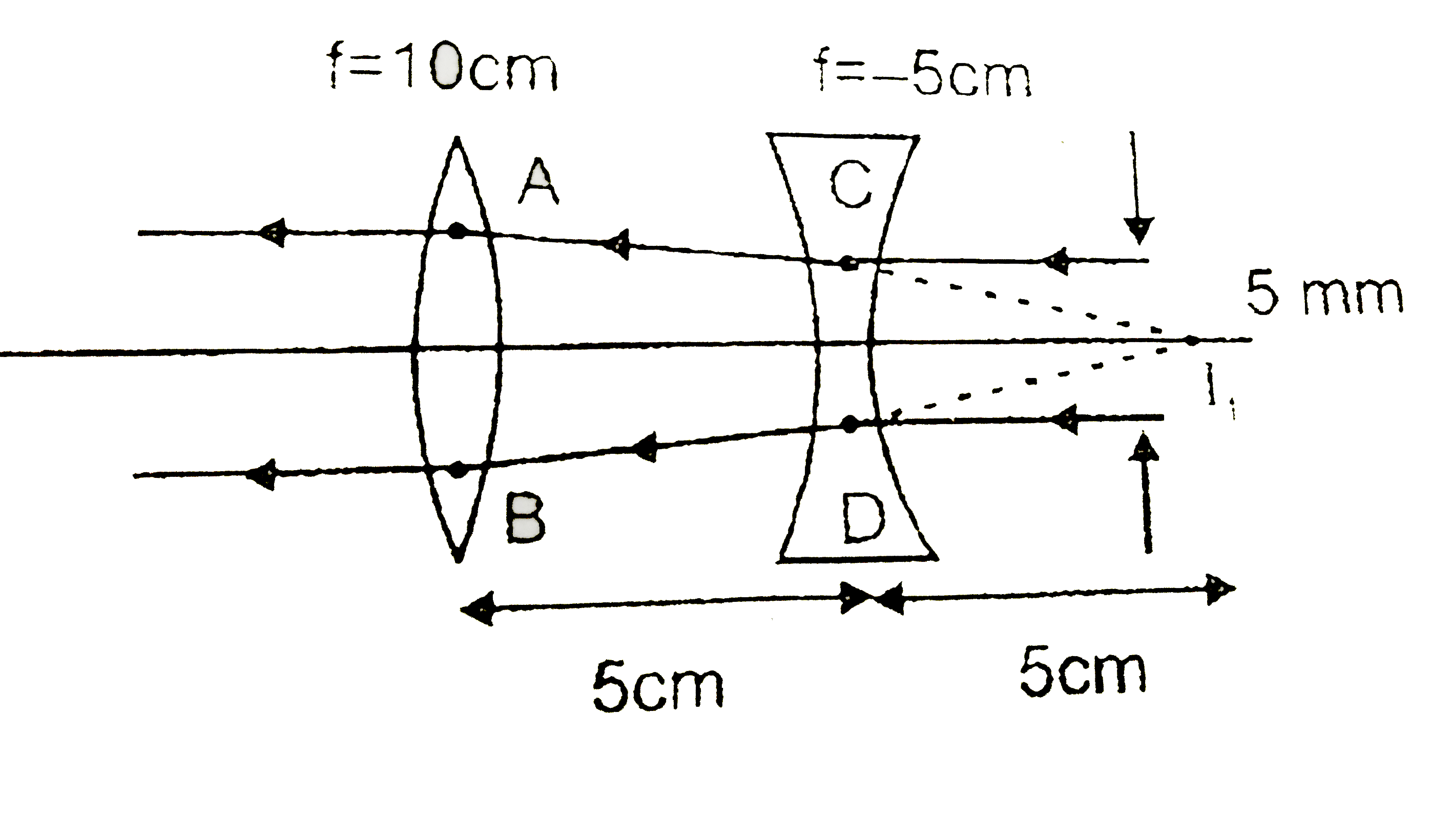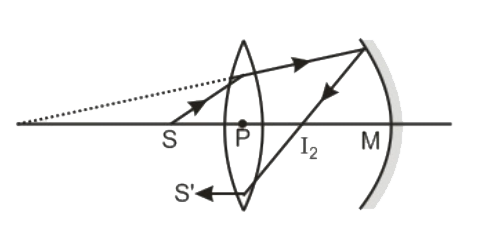A converging lens of focal length and a diverging lens of focal length are placed apart with their principle axes coinciding. A beam of light travelling parallel to the incident one. Find the beam diameter of the emergent beam is parallel to the incident one. Find the beam diamter of the emergent beam. Alos find out the ratio fo emergent and incident intensities.
The correct Answer is: if the light is incident form the side of concave lens and if it is incident form the side of the convex lens and the corresponding ratio of intensities are and
If light is incident form side of convex lens

For fianl light ray to be parallel to the axis of the lens, the image formed by the mirror should be at the focus of the lens.
therefore, the final beam wil be to incident ray.
Power, = constant
If light is incident form side of concave lens, first image is formed at the focus of concave lens means at the focus fo convex lens. Therefore, final ray will be to incident one.

Topper's Solved these Questions
- BOOK - RESONANCECHAPTER - GEOMATRICAL OPTICS EXERCISE - Exercise-263videos
GEOMATRICAL OPTICS
- BOOK - RESONANCECHAPTER - GEOMATRICAL OPTICS EXERCISE - Exercise-379videos
GEOMATRICAL OPTICS
- BOOK - RESONANCECHAPTER - GEOMATRICAL OPTICS EXERCISE - Problem33videos
GEOMATRICAL OPTICS
- BOOK - RESONANCECHAPTER - EXPERIMENTAL PHYSICSEXERCISE - PART -II10videos
EXPERIMENTAL PHYSICS
- BOOK - RESONANCECHAPTER - GRAVITATIONEXERCISE - HIGH LEVEL PROBLEMS16videos
GRAVITATION
Similar Questions
A convex lens of focal length 20 cm and a concave lens of focal length 10 cm are placed 10 cm apart with their principal axes coinciding. A beam of light travelling parallel to the principal axis and having a beam diameter 5.0 mm, is incident on the combination. Show that the emergent beam is parallel to the incident one. Find the beam diameter of the emergent beam.
View SolutionA light beam passes from medium 1 to medium 2. Show that the emerging beam is parallel to the incident beam.
View Solution
Knowledge Check
- Question 1 - Select One
A convex lens of focal length 10cm and concave lens of focal length 20cm are kept 5cm apart. The focal length of the equivalent lens is
A1203cmB18cmC30cmD403 - Question 2 - Select One
A convex lens of focal length 100 cm and a concave lens of focal length 10 cm are placed coaxialiy at a separation of 90 cm. If a parallel beam of light is incident on convex lens, then after passing through the two lenses the beam
AConvergesBDivergesCRemains parallelDDisappears - Question 3 - Select One
A convex lens A of focal length 20cm and a concave lens G of focal length 5cm are kept along the same axis with the distance d between them. If a parallel beam of light falling on A leaves B as a parallel beam, then distance d in cm will be
A25B15C30D50
A converging lens of focal length 5.0cm is placed in contact
with a diverging lens of focal length 10.0cm. Find the combined focal length of
the system.View SolutionA converging lens of focal length 15 cm and a converging mirror of focal length 10 cm are placed 50 cm apart with common principal axis. A point source is placed in between the lens and the mirror at a distance of 40 cm from the lens. Find the locations of the two images formed.
View SolutionA converging lens of focal length 20 cm and a converging mirror of focal length 10 cm are placed 60 cm apart with common principal axis. A point source is placed in between the lens and the mirror at a distance of 50 cm from the lens. Find the locations of the images formed.
View SolutionA light beam, passes from medium 1 to medium 2. Show that the emerging beam is parallel to the incident beam.
View SolutionA converging lens of focal length 15 cm and a converging mirror of focal length 20 cm are placed with their principal axes coinciding. A point source S is placed on the principal axis at a distance of 12 cm from the lens, as shown in figure. It is found that the final beam comes out parallel to the principal axis. Let the separation between the mirror and the lens be 10×k. Find k.
 View Solution
View Solution

